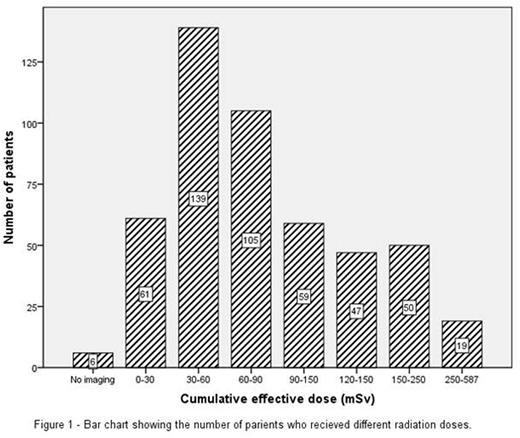Abstract
The American Cancer Society anticipates the diagnosis of 80,000 new cases of lymphoma in the US in 2013. Cancer Research UK estimates that more than 80% of Hodgkin Lymphoma (HL) patients and more than 60% of Non-Hodgkin Lymphoma (NHL) patients will be alive 5 or more years after diagnosis. As survival rates improve, focus shifts to ensuring quality of life in survivors and decreasing potential toxicity. Radiological procedures play a prominent role in diagnosis, staging and assessment of treatment response. Exposure to ionizing radiation has been linked to an increased risk of malignancy (Pearce et al 2012, Miglioretti et al 2013, Mathews et al 2013). Cumulative exposure in excess of 75mSv has been estimated to increase cancer mortality by 7.3% (Cardis et al 2007). There is a paucity of data in the literature regarding cumulative radiation exposure in patients with lymphoma. In cancer treatment, the aim is individualized management strategies. This should also be the goal for diagnostic procedures (O' Neill et al 2011, Fletcher et al 2012).
A retrospective review of all patients on a prospectively maintained database with biopsy proven HL or NHL between January 2009 and July 2012 was conducted in a University hospital group. The cumulative effective radiation dose (CED) was calculated using standardized procedure-specific radiation dose levels.
Four hundred and eighty six patients were included in the study. Mean (SD) age at diagnosis was 59 (17) years and 15% were aged < 40. Fifty-nine percent were men. Sixteen percent had HL; 84% had NHL. There were a total of 1127 patient-years of follow-up, with 15% having <1 year and 10% having 5 or more years of follow-up.
Ninety-nine per cent of patients had diagnostic imaging. A total of 5748 radiological procedures were performed, equivalent to one procedure every 70 patient days of follow-up.
The median estimated total CED ( IQR) per subject was 69mSv (42-118). Forty- six percent had a total CED >75mSv and 14% had a total CED >150mSv – SeeFigure 1. CT contributed 89% of the radiation dose and PET-CT contributed 8%.
Patients aged <40 had a median CED (IQR) of 89mSv (55-124). Seventy-five per cent of these patients had a potentially curable malignancy (66% had HL; 5% had Diffuse Large B Cell Lymphoma; 4% had Burkitt Lymphoma). Patients who underwent stem cell transplantation had a median CED (IQR) of 162mSv (135-225) with 59% having radiotherapy as part of their management.
Univariate analysis showed that age (p<0.001), duration of lymphoma (p<0.001) and stage (<0.001) were associated with CED.
This study highlights the considerable ionizing radiation exposure from diagnostic imaging in patients with lymphoma. This is especially relevant in young people who would be considered the most radiosensitive and at highest risk for secondary malignancies.
Low grade lymphomas are relapsing and remitting in nature and frequently require re-staging imaging over many years. Longer follow-up will be required here to potentially explain the non-significant trend between histological subtype and different CED.
The American College of Radiology stated in 2013 that when used appropriately, the benefits of ionizing radiation far outweigh the risks. However, to minimize risk, institutions should participate in national dose registries. With the widespread use of Picture Archiving and Communication System (PACS), this will be feasible.
Low dose CT imaging has emerged as a mechanism for minimizing CED. Dose reduction strategies incorporating patient-specific information would optimize imaging while minimizing the harmful effects (Shah et al 2012). Novel CT reconstruction algorithms allow diagnostic quality imaging to be obtained at reduced radiation doses without the prohibitive noise that would otherwise be present (Prakash et al 2010).
Procedures which do not involve ionizing radiation such as MRI and ultrasound are becoming increasingly popular. There is growing interest in PET-MRI for staging of malignancies (Appenzeller 2013) but as yet, PET-CT remains superior.
For patients with potentially curable lymphoma, particularly young patients with higher CED, consideration should be given to these strategies.
No relevant conflicts of interest to declare.
Author notes
Asterisk with author names denotes non-ASH members.


This feature is available to Subscribers Only
Sign In or Create an Account Close Modal